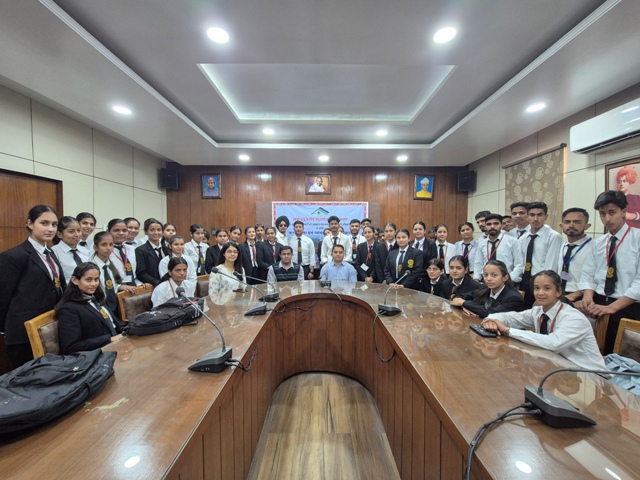Empowering Communities for Clean Air: Enhancing Public Understanding and Skill Development for Air Quality Monitoring and Management in Himachal Pradesh
Air pollution has become a critical environmental issue in the 21st century, particularly in regions like Himachal Pradesh, which is known for its stunning natural beauty. However, this state is increasingly facing challenges related to air quality due to both human activities and natural phenomena. While discussions on air pollution often center around urban industrial areas, it is essential to acknowledge the rising threat in rural and semi-urban regions, where factors such as vehicular emissions, biomass burning, industrial growth, and climate-related forest fires contribute to deteriorating air quality.Himachal Pradesh's unique geography, which includes high-altitude ecosystems and valley inversions, complicates the air quality situation. These geographical features, combined with transboundary pollution from neighboring states, exacerbate the air quality issues faced by the region. Despite various initiatives by governmental and non-governmental organizations, there remains a significant gap in public awareness, community involvement, and technical capacity for effective air quality monitoring and management.The rationale for this study is rooted in the urgent need to enhance community participation in air quality governance. Air pollution has far-reaching consequences, affecting not only human health but also ecological balance, agricultural productivity, and socio-economic stability. To tackle this challenge, a multi-faceted approach is necessary, one that integrates scientific monitoring, policy frameworks, and active community engagement. By empowering local populations with knowledge and technical skills, it is possible to establish a sustainable and inclusive air quality management system in Himachal Pradesh.
The significance of this study lies in its emphasis on community-centric solutions for air quality management. Traditional strategies for mitigating air pollution often rely on centralized regulatory mechanisms that may not be adaptable to local contexts. By leveraging scientific research and grassroots mobilization, this study contributes to a holistic model for air quality governance.The objectives of the study include building public awareness and technical capacity within local communities and stakeholders in Himachal Pradesh, enabling them to actively contribute to air quality monitoring and management. This involves increasing public awareness of air pollution, providing training opportunities, encouraging community-led activities, and creating platforms for public access to air quality data.Himachal Pradesh, located in the western Himalayas, is characterized by diverse geography and climate, with significant variations in elevation and vegetation. The state's economy relies heavily on agriculture, horticulture, hydropower, and tourism. However, recent industrialization and urban expansion have begun to affect environmental conditions, leading to localized air pollution issues. The state's complex topography, including deep valleys and enclosed basins, creates conditions where pollutants accumulate, resulting in poor air quality.Air pollution in Himachal Pradesh arises from various sources, including vehicular emissions, industrial activities, biomass burning, and natural processes like forest fires. The geographical features of the state exacerbate pollution-related challenges, leading to significant air quality concerns. Despite efforts by pollution control agencies, there remains a need for localized air quality monitoring and public engagement to address these challenges effectively.
To comprehensively assess air pollution in Himachal Pradesh, the study focused on four key regions: Baddi (an industrial hub), Una (a stubble burning region), Bilaspur (a cement factory region), and Kullu (a tourism area). Each location presents distinct pollution sources, enabling a thorough evaluation of air quality challenges.The methodology employed an interactive and participatory approach to enhance awareness and understanding of air pollution among students and local communities. A structured lecture-based intervention was followed by hands-on group activities to encourage critical thinking. The impact of the intervention was assessed through pre- and post-analysis questionnaires measuring changes in knowledge and awareness levels regarding air pollution.The results indicated that participants initially possessed limited awareness of air pollution sources and impacts. However, following the educational session, there was a notable improvement in comprehension, suggesting that the combination of lectures and interactive activities effectively bolstered participants' understanding of air pollution and its mitigation strategies.The group activities encouraged participants to analyze specific air pollution sources, fostering critical thinking and collaborative learning. Each group identified problems associated with their assigned pollution source, evaluated existing remedies, and proposed innovative solutions. This collaborative approach not only enhanced problem-solving skills but also encouraged participants to think beyond conventional mitigation strategies.The study highlighted the importance of community engagement in fostering a deeper connection with environmental issues. Nearly 90% of participants exhibited an increased understanding of air quality issues, while 75% actively participated in discussions and activities. Such engagement is crucial for the success of environmental initiatives, as community involvement leads to more sustainable and effective outcomes.Future directions for this initiative include continuous monitoring and data collection, integration with government policies, expansion of educational programs, and the establishment of local committees for periodic air quality assessments. By institutionalizing these approaches, regions like Himachal Pradesh can progress toward a sustainable and inclusive air quality management framework that actively involves the community in pollution mitigation efforts.In conclusion, the findings of this study underscore the critical role of public awareness and community participation in addressing environmental challenges such as air pollution. The educational intervention demonstrated a significant improvement in participants' understanding of air pollution sources, impacts, and mitigation strategies. By engaging students and community members in hands-on learning experiences, the initiative successfully encouraged critical thinking and problem-solving, enabling participants to identify key environmental concerns and propose innovative solutions.Public awareness campaigns on critical environmental issues are essential for fostering informed decision-making and sustainable behaviors. Future efforts should focus on scaling up these initiatives, incorporating long-term monitoring mechanisms, and establishing stronger partnerships with educational institutions and governmental agencies. By empowering communities with the knowledge and tools to actively engage in environmental governance, we can collectively work toward a cleaner, healthier, and more sustainable future.



